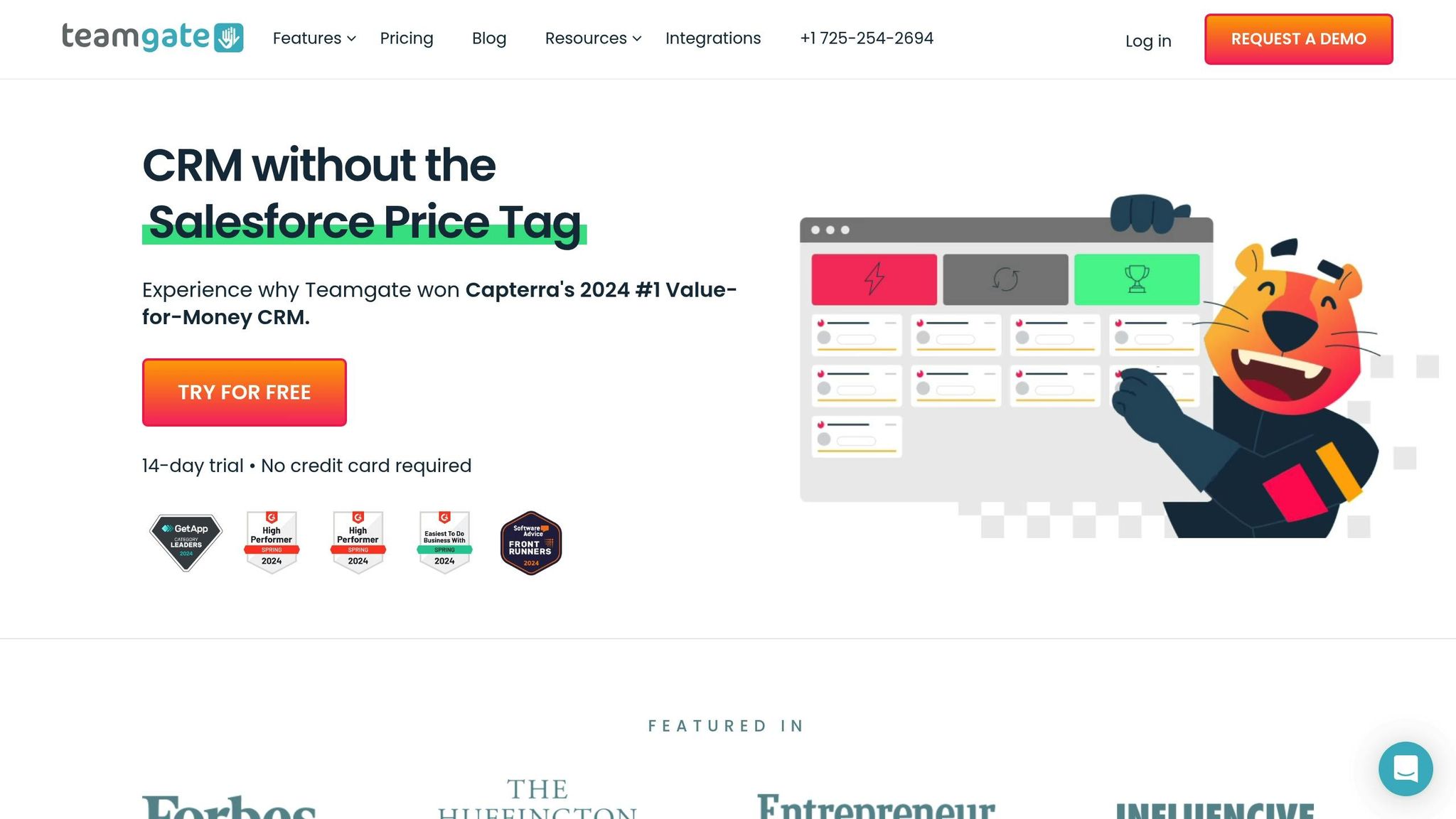Running your business without a CRM is costing you time, money, and growth opportunities. Here’s how:
- Lost Revenue: Leads slip through the cracks, follow-ups are missed, and slow response times drive customers to competitors.
- Higher Costs: Manual tasks, scattered tools, and data errors waste time and money.
- Limited Growth: Without analytics, decisions are based on guesswork, making it harder to scale or retain customers.
For example, businesses lose 12% of revenue due to bad data, and a sales rep spending 3 extra hours daily on admin tasks costs $22,500 annually in wasted productivity. A CRM like Teamgate can centralize processes, automate tasks, and save costs, starting at $39.90 per user/month.
Quick Overview:
| Problem | Without CRM | With CRM (e.g., Teamgate) |
|---|---|---|
| Lead Management | Missed opportunities, slow follow-ups | Automated tracking and follow-ups |
| Task Management | Time wasted on manual tasks | Streamlined workflows |
| Software Costs | High costs from multiple tools | All-in-one platform |
| Data Accuracy | Frequent errors and duplicates | Automated validation and insights |
Don’t wait – every day without a CRM adds to inefficiencies and lost revenue.
Why Use a CRM? 3 Unbelievable CRM Benefits in Under 4 …
Direct Revenue Losses Without CRM Systems
Running a business without a CRM can hurt your revenue in clear and measurable ways. Here’s how companies lose money when customer relationships aren’t effectively managed.
Lost Sales from Untracked Leads
Leads that aren’t tracked properly often fall through the cracks, directly affecting sales and overall revenue:
- Poor Lead Prioritization: Without tools to rank leads by quality, sales teams waste time on less promising prospects while high-value opportunities slip away.
- Disorganized Lead Information: Scattered notes and incomplete data lead to misaligned sales strategies, duplicate outreach efforts, and missed opportunities for effective targeting.
- Landing Page Inefficiencies: Without integrated tracking, it’s harder to optimize lead capture, causing potential customers to drop off before they even enter the sales funnel.
These issues don’t just affect immediate sales – they also weaken your ability to build long-term customer relationships.
Reduced Customer Revenue Over Time
When customer data is fragmented, it’s harder to identify growth opportunities, maintain strong relationships, and boost lifetime value.
- Missed Opportunities for Upselling: Without access to detailed purchase history or interaction data, sales teams may overlook chances to recommend additional products or services.
- Weak Relationship Management: A lack of unified customer insights makes it difficult to nurture relationships, leading to fewer referrals and less loyalty.
These missed opportunities can significantly impact your bottom line over time.
Sales Lost to Slow Response Times
Speed matters in today’s competitive market. Delayed responses can cost you sales and damage your reputation:
- Follow-up Delays: Slow follow-ups often result in lost deals as prospects move on to competitors.
- Inconsistent Communication: Without automated reminders or task management, sales teams may forget to:
- Follow up on time
- Share requested details promptly
- Schedule demos or meetings when needed
These delays not only hurt individual sales but also add up over time, leading to lost market share, declining customer loyalty, and slower business growth.
Hidden Costs of Manual Operations
Manual processes can eat up resources, pulling time and money away from activities that drive revenue.
Time Spent on Manual Tasks
Sales teams often lose hours handling repetitive administrative work instead of focusing on selling. Common tasks include:
- Entering data
- Searching for customer information
- Creating sales quotes
- Following up on leads manually
- Generating reports
For example, a sales rep earning $60,000 annually who spends three extra hours a day on these tasks ends up costing the company about $22,500 each year in wasted productivity. These inefficiencies pave the way for additional expenses caused by fragmented tools and data errors.
Financial Drain from Using Multiple Tools
Beyond lost time, relying on multiple tools can significantly increase costs. These include:
- Subscription fees for various platforms
- Training and IT support expenses
- Challenges with integrating different systems
- Issues with keeping data synchronized
By consolidating these functions into one platform, businesses can reduce software expenses and simplify system management.
The Price of Data Entry Errors
Handling data manually often leads to mistakes that can be expensive. As Karri Bishop, Marketing Communications Manager at TechnologyAdvice, explains:
"In sales, data is your most valuable asset. When that data doesn’t get the attention it needs, your customers, your operations, and your bottom line can all suffer."
The financial losses are notable:
- Companies lose an average of 12% of revenue due to bad data
- Duplicate records drive up marketing expenses and skew operational insights
These errors don’t just disrupt decision-making; they also lead to higher marketing and operational costs.
sbb-itb-5772723
Barriers to Business Growth
Inefficiencies and lost revenue don’t just affect daily operations – they also create long-term challenges that can hold businesses back. Without a CRM system in place, these obstacles grow over time, impacting both short-term performance and future success.
Limited Team Growth
A small team might manage with scattered tools and methods, but as the team size doubles, so does the confusion. Key issues include:
- Poor team communication
- Ineffective lead distribution
- Lack of standardized processes
- Longer onboarding periods
- Difficulty tracking performance
Without clear systems, scaling becomes chaotic. New employees take longer to become productive, while experienced team members spend more time on admin tasks than driving sales. This disorganization makes it tough to maintain quality and track performance effectively.
Missing Sales Performance Data
When businesses lack detailed sales analytics, decision-making becomes a guessing game. Sales managers often struggle to:
- Monitor performance and predict revenue
- Identify bottlenecks in the sales process
- Allocate resources effectively
- Calculate customer acquisition costs
Relying on instinct rather than data is risky, especially when planning for growth or entering new markets. Without clear metrics, businesses also find it harder to nurture strong customer relationships.
Decreased Customer Loyalty
Without a centralized system to manage customer interactions and preferences, delivering the personalized experiences customers expect becomes nearly impossible. The results include:
- Inconsistent service quality
- Slow response times
- Missed follow-ups
- Poor tracking of satisfaction levels
- Lost opportunities for additional revenue
Failing to keep detailed records of customer history and preferences weakens retention and reduces lifetime value. Businesses lose out on repeat customers and struggle to build lasting relationships.
| Growth Area | Impact | Consequence |
|---|---|---|
| Team Expansion | Disorganized processes | Higher costs, slower scaling |
| Sales Performance | Limited visibility | Inefficient resource use |
| Customer Engagement | Fragmented information | Lower retention, lost value |
These barriers don’t just slow growth – they can lead to setbacks that ripple through the business. The larger a company grows, the more costly it becomes to operate without the right CRM tools, making it harder to stay competitive in the market.
How Teamgate CRM Reduces These Costs

Tackling inefficiencies requires a single, effective solution – this is where Teamgate CRM comes in.
Centralized Sales Management
Teamgate CRM brings all key sales functions together on one platform. It handles lead tracking, customer communication, and sales pipeline management, eliminating the need to jump between multiple tools.
With built-in email, SmartDialer, and data integration, sales teams can manage interactions effortlessly, ensuring no leads slip through the cracks. This setup not only simplifies workflows but also trims the costs associated with extra software.
"With Teamgate’s intuitive interface, our user adoption was immediate. Even with a remote team consisting of sales, customer success and marketing – we were onboarded and up and running within hours." – Jack Hodges, Sales Manager, FiveCRM
Lower Software Costs
By combining various tools into one platform, Teamgate CRM offers a more cost-efficient option. It replaces the need for separate subscriptions for contact management, email marketing, phone systems, analytics, and pipeline tracking.
This approach cuts direct software costs and saves time by simplifying vendor management and integrations. For businesses looking to scale, it offers straightforward and predictable pricing.
Growth-Focused Tools
Teamgate CRM provides analytics and automation features designed to support business growth. Its suite of tools helps refine sales processes and strengthen customer relationships.
"With in depth insights and metrics, Teamgate truely is the only CRM designed specifically for SaaS teams… We were up and running within days and immediately increased productivity and efficiency of our sales teams resulting in a 132% increase in conversion rates!" – Allison Barkley, Director of Operations, Baremetrics
Key features like sales intelligence, lead scoring, workflow automation, multi-currency support, and advanced reporting ensure every $1 invested delivers an average return of over $8. Plus, its support for phone conversations – proven to convert leads 70% more effectively – boosts overall conversion rates.
Altogether, these tools make Teamgate CRM a complete solution for reducing both visible and hidden costs tied to outdated processes.
Conclusion: The Cost of Waiting vs. Implementing a CRM
Missed leads, inefficient processes, and wasted resources can seriously hinder your business growth. Postponing the adoption of a CRM system leads to unnecessary financial and operational burdens. Without a CRM, you risk losing track of leads, juggling disconnected tools, and spending too much time on manual tasks. On the other hand, implementing a CRM is an investment that sets the stage for sustainable growth.
Here’s a breakdown of the potential cost savings with Teamgate CRM:
| Cost Category | Without CRM | With Teamgate CRM |
|---|---|---|
| Lead Management | Revenue loss from missed opportunities | Automated tracking and follow-up |
| Task Management | Hours wasted on repetitive manual tasks | Streamlined workflows |
| Software Costs | High costs from using multiple tools | All-in-one platform |
| Data Accuracy | Time spent fixing errors | Built-in automation and validation |
Teamgate CRM, starting at $39.90 per user per month, offers tools like lead scoring and advanced analytics to help businesses maximize efficiency. By consolidating processes into one platform, it allows teams to focus on what matters most: building relationships and closing deals. This approach not only reduces costs but also enhances productivity and market reach.
The real question is: how much longer can your business afford to delay? Every day of inaction adds to inefficiencies, while Teamgate CRM offers immediate improvements in lead management and overall performance.
FAQs
How can a CRM help reduce manual work and boost productivity for my business?
A CRM helps minimize manual work and enhances productivity by centralizing all your customer data in one system, eliminating duplicate records, and automating repetitive tasks. This streamlines workflows, making it easier to track leads, manage sales pipelines, and plan future activities efficiently.
By automating processes like follow-ups, data entry, and reporting, a CRM saves valuable time and reduces errors. This allows your team to focus on building relationships and closing deals, ultimately driving growth for your business.
How does a CRM system enhance data accuracy, and what are the risks of relying on inaccurate data for your business?
A CRM system enhances data accuracy by centralizing all customer information in one place, reducing duplicate records and ensuring data consistency. This streamlined approach allows your team to access up-to-date and reliable information, improving decision-making and operational efficiency.
Inaccurate data can have serious consequences for your business. It may lead to wasted marketing budgets, such as targeting customers who have already been contacted or sending irrelevant offers. Additionally, poor data can result in missed sales opportunities, damaged customer relationships, and inefficiencies that slow down your team’s productivity. By maintaining accurate data, you can save time, reduce costs, and drive sustainable growth.
How can using a CRM help improve customer retention and boost revenue over time?
Using a CRM can significantly improve customer retention and drive revenue growth by creating personalized customer experiences and enhancing engagement. With a CRM, you can track each customer’s history, preferences, and interactions, allowing you to anticipate their needs and provide tailored solutions. This not only strengthens relationships but also fosters long-term loyalty.
Additionally, a CRM helps businesses stay proactive by identifying patterns in customer behavior, addressing issues quickly, and reducing churn. By streamlining communication and centralizing data, your team can focus on delivering exceptional service, which ultimately leads to happier customers and sustainable revenue growth.





